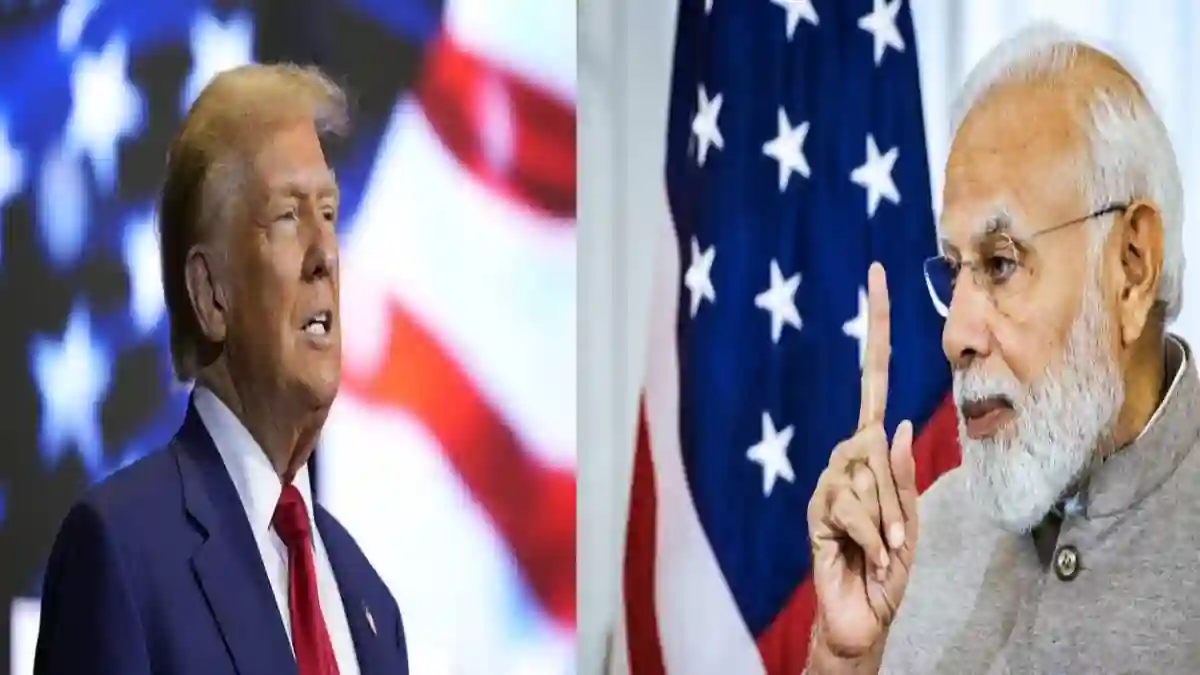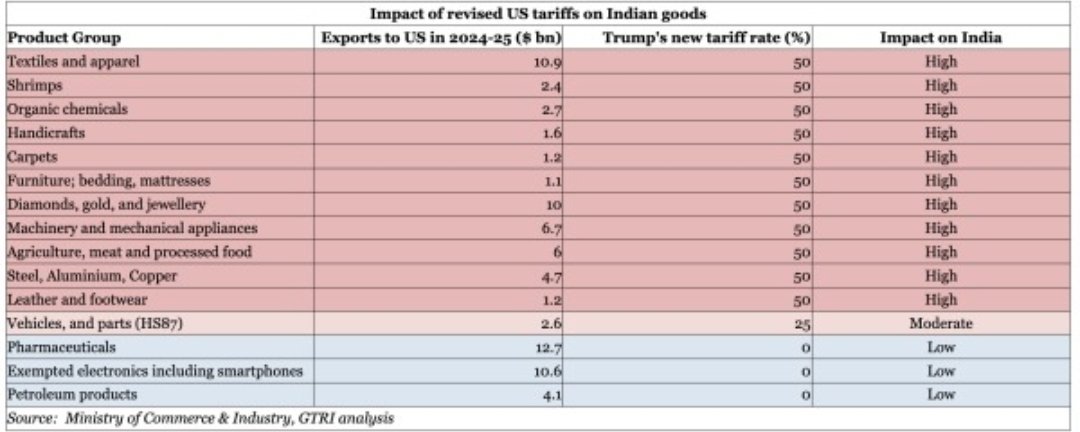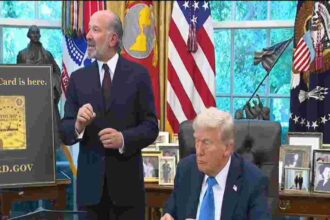
Ahmedabad, India: The Ministry of Commerce and Industry, along with GTRI analysis, has released a detailed report showing the impact of Trump’s tariffs on India, which have now officially come into effect. U.S. President Donald Trump has imposed a 50% tariff on a wide range of Indian goods, jeopardizing the long standing trade relationship between New Delhi and Washington.
But beyond economics, there lies a deeper political narrative. Trump, who once claimed credit for preventing a war between India and Pakistan, is reportedly frustrated that India has not aligned with his global positions. In reality, it was the Pakistan DGMO who contacted the Indian DGMO to stop escalation, and the U.S. had no real role in preventing conflict. Many in India’s strategic circles argue that New Delhi has become a hurdle in Trump’s dream of winning a Nobel Peace Prize, and for personal ambitions, the White House has now turned trade into a weapon.
Trump’s Tariffs on India: The Hard Hit Sectors
According to the official report from the Ministry of Commerce and GTRI, the new U.S. tariff structure disproportionately impacts sectors that form the backbone of Indian exports:
| Product Group | Exports to US in 2024-25 ($ bn) | Trump’s New Tariff Rate (%) | Impact on India |
|---|---|---|---|
| Textiles and apparel | 10.9 | 50 | High |
| Shrimps | 2.4 | 50 | High |
| Organic chemicals | 2.7 | 50 | High |
| Handicrafts | 1.6 | 50 | High |
| Carpets | 1.2 | 50 | High |
| Furniture; bedding, mattresses | 1.1 | 50 | High |
| Diamonds, gold, and jewellery | 10 | 50 | High |
| Machinery and mechanical appliances | 6.7 | 50 | High |
| Agriculture, meat and processed food | 6 | 50 | High |
| Steel, Aluminium, Copper | 4.7 | 50 | High |
| Leather and footwear | 1.2 | 50 | High |
| Vehicles, and parts (HS87) | 2.6 | 25 | Moderate |
| Pharmaceuticals | 12.7 | 0 | Low |
| Exempted electronics including smartphones | 10.6 | 0 | Low |
| Petroleum products | 4.1 | 0 | Low |
Source: Ministry of Commerce & Industry, GTRI analysis
This shows that while sectors like pharmaceuticals, electronics, and petroleum products remain exempt, the labour intensive industries such as textiles, shrimps, jewellery, and handicrafts face devastating consequences.

Economic Impact on India
The economic blow from Trump’s tariffs on India is severe. High-value exports such as diamonds, textiles, and machinery, which collectively account for billions in annual trade, are now under threat. A 50% tariff effectively prices Indian goods out of the U.S. market, making them less competitive against cheaper alternatives from Vietnam, Bangladesh, or Mexico.
For India, this will mean:
Job losses in sectors like textiles, leather, and jewellery, which employ millions.
Falling export revenues, worsening the trade balance.
Strain on MSMEs, especially in handicrafts and carpets, which rely heavily on U.S. buyers.
Trump’s Personal Ambition vs. India’s Sovereignty
The deeper question is why now. Trump has repeatedly positioned himself as a “deal maker” and once claimed he stopped a war between India and Pakistan. However, as insiders point out, it was a direct DGMO to DGMO contact between India and Pakistan that de-escalated the situation. The U.S. & US President Donald Trump played no role in this.
For Trump, India’s refusal to endorse his narrative has become a political thorn. Analysts argue that New Delhi’s independent stance on foreign policy is seen by Trump as a block to his Nobel Peace Prize ambitions. Thus, the tariffs are less about economics and more about pressuring India for personal political gain.
Social Impact
The social consequences of Trump’s tariffs on India cannot be ignored. Millions of workers in India’s textile hubs, jewellery workshops, and leather tanneries stand at risk of unemployment. Small family run businesses that dominate handicrafts and carpets will be pushed into crisis.
Moreover, this trade war narrative could fuel anti-American sentiment in India, especially among business communities who see their livelihoods destroyed not by market forces, but by political decisions made in Washington.
How Trump’s Tariffs Could Backfire on the U.S.
Ironically, while Trump’s tariffs on India aim to pressure New Delhi, they could backfire badly on the U.S. economy:
1. Higher prices for American consumers: Indian textiles, jewellery, and processed foods are popular in the U.S. A 50% tariff will make these unaffordable, forcing Americans to pay more.
2. Disruption in supply chains: Sectors like machinery and chemicals are part of integrated global supply chains. Restricting Indian inputs could hurt U.S. industries.
3. Pharmaceutical dependency: While pharma is exempt for now, if India retaliates by restricting supply of essential drugs, the U.S. healthcare system could face shortages.
4. Loss of goodwill in Asia: By targeting India, Trump risks weakening America’s strategic partnership in the Indo-Pacific at a time when countering China is crucial.
Diplomatic Fallout
This aggressive trade stance risks undoing decades of progress in U.S.-India relations. Instead of cooperation on technology, defense, and trade, the two democracies are drifting toward confrontation. For India, aligning with Russia and alternative trade blocs may become a strategic necessity.
At a time when the U.S. needs strong partners, Trump’s approach is isolating Washington.
Conclusion
The newly announced Trump’s tariffs on India represent more than just a trade dispute. They reflect the White House’s frustration with India’s independent stance and its unwillingness to play into Trump’s personal ambitions of being seen as a “global peacemaker.”
While India will face short term economic pain, the long term political cost for the U.S. could be far higher. Rising prices for American consumers, damaged diplomatic ties, and the loss of trust from a key ally may prove that in trying to punish India, Trump has in fact weakened America’s own position.
Contact us: contact@thenewsdrill.com
Submit tip or story: editor@thenewsdrill.com or visit our contributor page.
Stay updated with The News Drill (TND) for the latest on global trade, politics, and diplomacy.













